牛津译林版(2019)必修 第三册Unit 4 Scientists who changed the world Extended reading 课件 (共25张PPT,内镶嵌视频)
文档属性
| 名称 | 牛津译林版(2019)必修 第三册Unit 4 Scientists who changed the world Extended reading 课件 (共25张PPT,内镶嵌视频) | 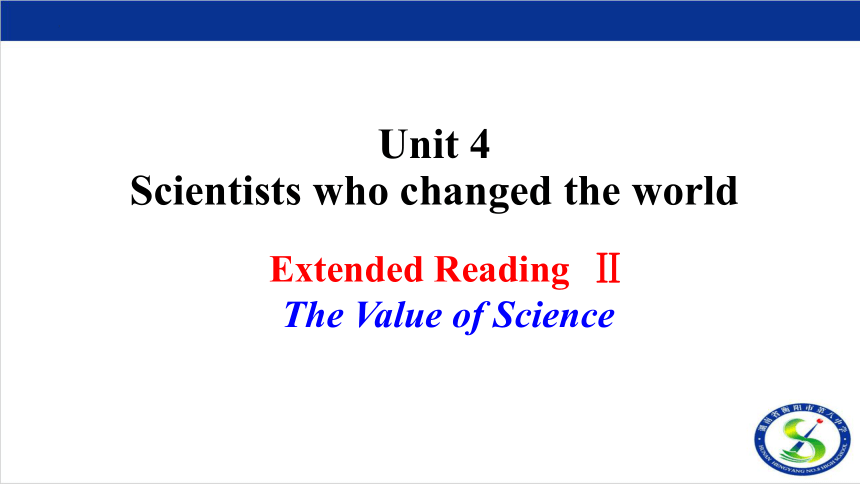 | |
| 格式 | pptx | ||
| 文件大小 | 22.5MB | ||
| 资源类型 | 教案 | ||
| 版本资源 | 牛津译林版(2019) | ||
| 科目 | 英语 | ||
| 更新时间 | 2023-07-14 08:08:29 | ||
图片预览

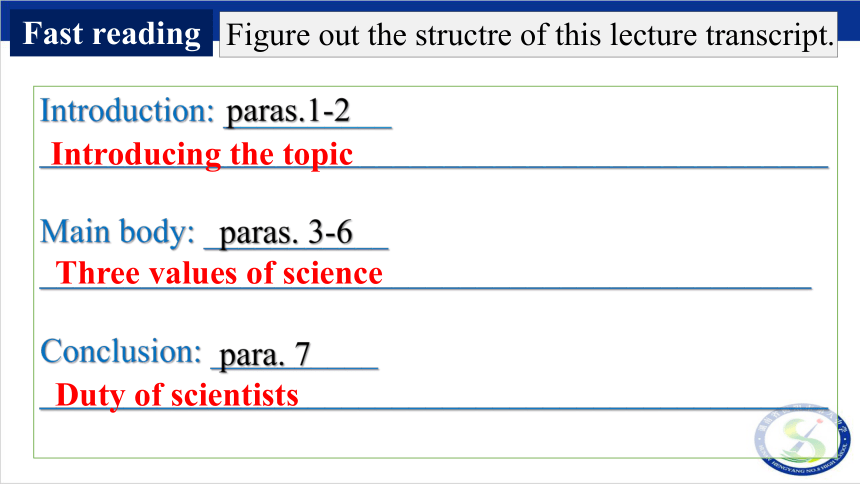
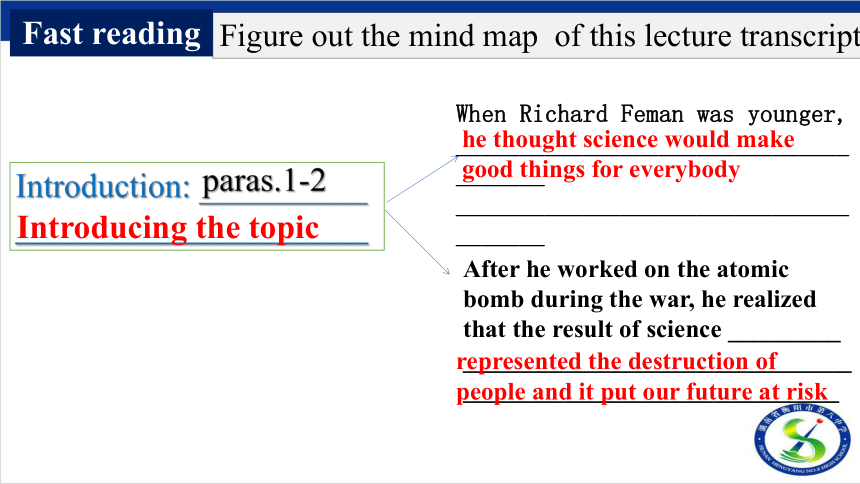
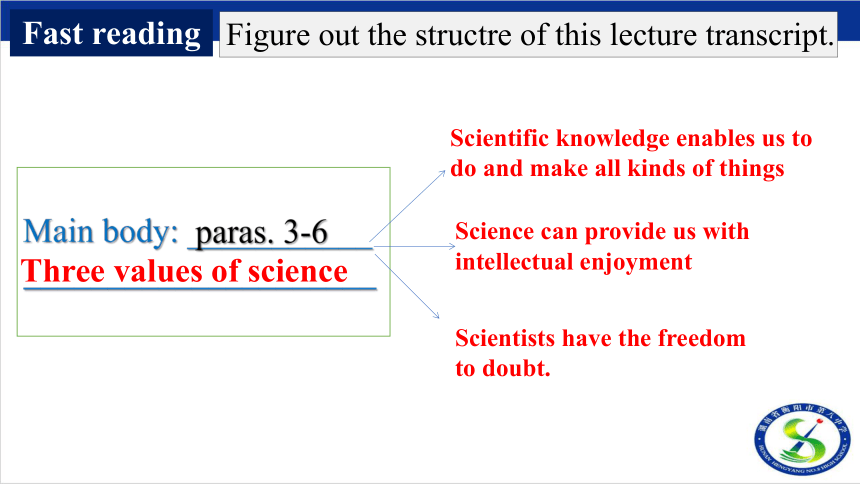
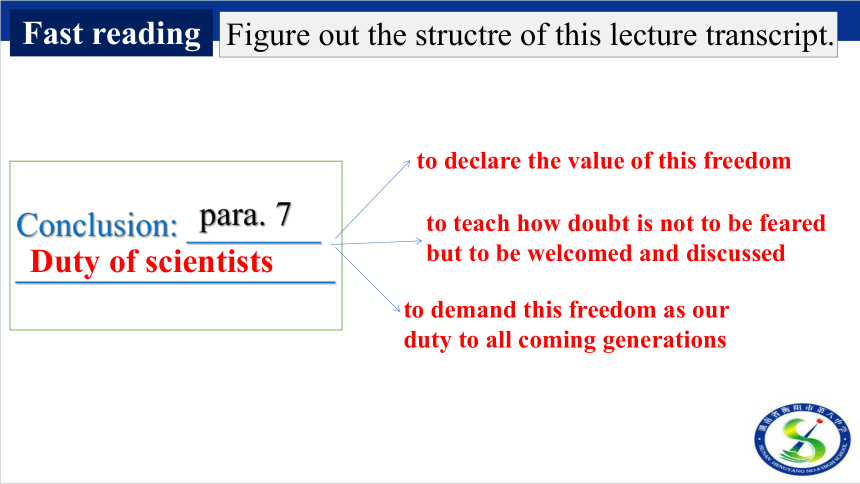
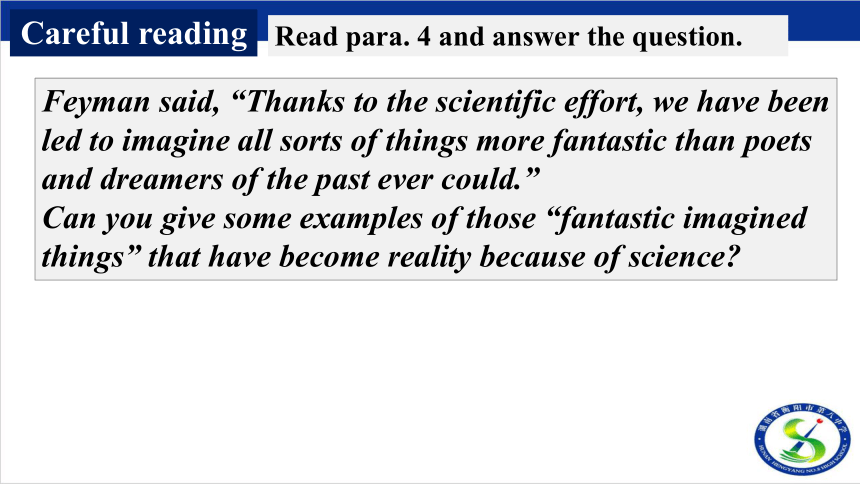
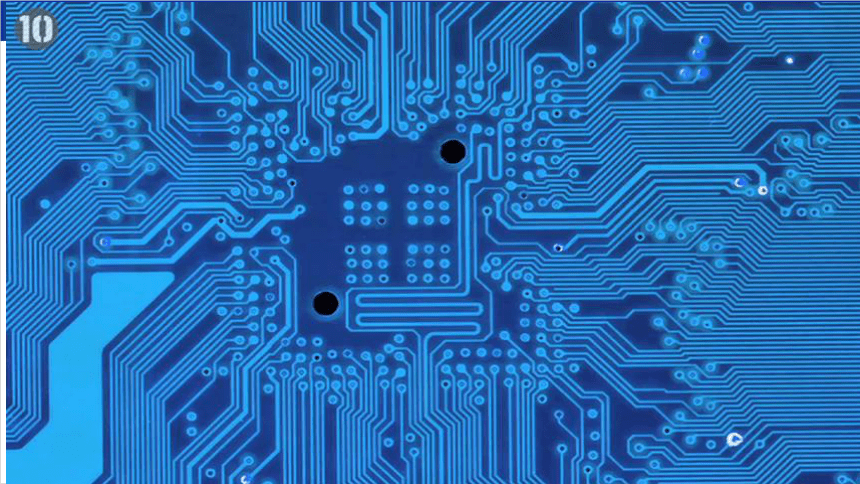
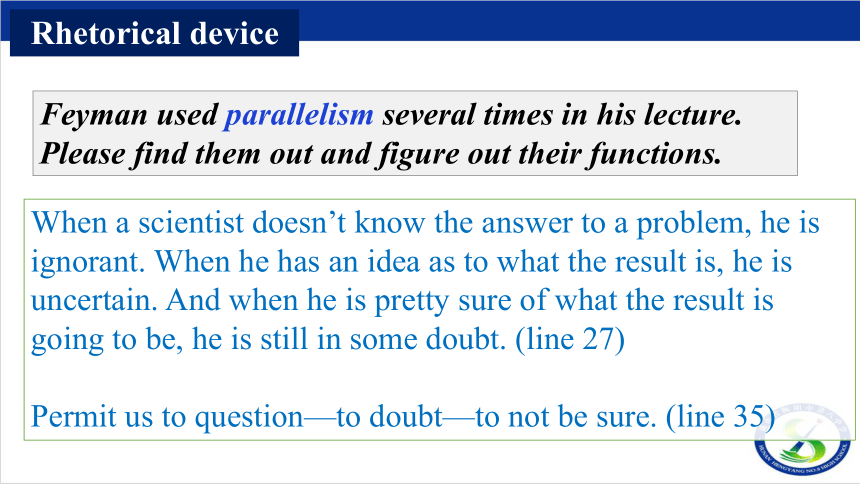
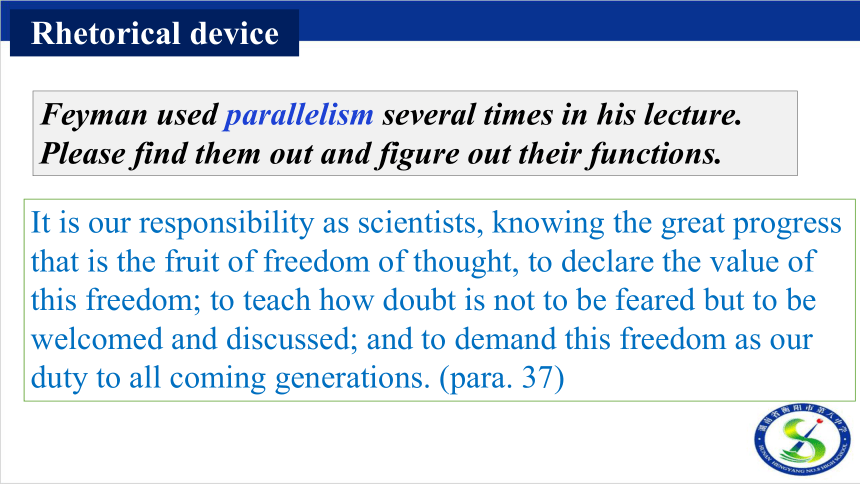
文档简介
(共25张PPT)
Extended Reading Ⅱ
The Value of Science
Unit 4
Scientists who changed the world
Introduction: __________
_______________________________________________
Main body: ___________
______________________________________________
Conclusion: __________
_______________________________________________
Introducing the topic
Three values of science
Duty of scientists
Figure out the structre of this lecture transcript.
paras.1-2
paras. 3-6
para. 7
Fast reading
Introduction: __________
_____________________
Introducing the topic
Figure out the mind map of this lecture transcript.
paras.1-2
Fast reading
When Richard Feman was younger, ______________________________________
______________________________________
After he worked on the atomic bomb during the war, he realized that the result of science _________
_______________________________
______________________________
he thought science would make good things for everybody
represented the destruction of people and it put our future at risk
Main body: ___________
_____________________
Figure out the structre of this lecture transcript.
Fast reading
paras. 3-6
Three values of science
Scientific knowledge enables us to do and make all kinds of things
Science can provide us with intellectual enjoyment
Scientists have the freedom to doubt.
Conclusion: ________
___________________
Duty of scientists
Figure out the structre of this lecture transcript.
para. 7
Fast reading
to declare the value of this freedom
to demand this freedom as our duty to all coming generations
to teach how doubt is not to be feared but to be welcomed and discussed
Careful reading
Feyman said, “Thanks to the scientific effort, we have been led to imagine all sorts of things more fantastic than poets and dreamers of the past ever could.”
Can you give some examples of those “fantastic imagined things” that have become reality because of science
Read para. 4 and answer the question.
Rhetorical device
When a scientist doesn’t know the answer to a problem, he is ignorant. When he has an idea as to what the result is, he is uncertain. And when he is pretty sure of what the result is going to be, he is still in some doubt. (line 27)
Permit us to question—to doubt—to not be sure. (line 35)
Feyman used parallelism several times in his lecture.
Please find them out and figure out their functions.
Rhetorical device
It is our responsibility as scientists, knowing the great progress that is the fruit of freedom of thought, to declare the value of this freedom; to teach how doubt is not to be feared but to be welcomed and discussed; and to demand this freedom as our duty to all coming generations. (para. 37)
Feyman used parallelism several times in his lecture.
Please find them out and figure out their functions.
Rhetorical device
Parallelism is the repetition of similar grammatical forms. It helps make an idea or argument clear and easy to remember. It also shows that each repeated structure is of equal importance. Parallelism is a powerful tool in public speaking and writing.
The function of parallelism
Rhetorical device
It is an analogy. Here Feyman compares the intellectual enjoyment of finding unimagined strangeness to the process of discovering what is hidden under a stone—just as underneath stones there could be an unknown treasure. Feyman uses this analogy to emphasize the curiosity and determination that scientists use to uncover mysteries and answer questions.
“Never concerned that the answer may let us down, with pleasure and confidence we turn over each new stone to find unimagined strangeness leading on to more wonderful questions and mysteries.”
What analogy is used here and what’s the function
Language Points
1. it represented the destruction of people and it put our future at risk. (Lines3-5)
risk v. & n.
冒生死之险 v. ____________________________
冒险做... v. ____________________________
n. ____________________________
risk one’s life / lives
risk doing
run/take the risk of sth/ doing
常见短语搭配:
处境危险,在危险中 at risk
自担风险,对发生的事情负责 at one’s own risk
冒...的危险 at the risk of
Have a try:
1. They risk _________(lose) everything.
2. The medical staff _______ the risk of losing their own lives in the battele against COVID-19 last year.
3. He saved my life ____________ losing his own.
4. Persons swimming beyond this point do so _______________(冒着自身风险).
5. That would mean putting other children ______(处境危险)
at the risk of
losing
at their own risk
at risk
ran/ took
2. Is there some evil involved in science (Lines 4-5)
involve sb/sth in sth/doing sb/sth be involved in doing
使参与,陷入或牵扯到
不要把我卷入你们的争吵当中。
Don't involve me in your quarrel.
贫穷使他家陷入不幸。
Poverty involved his family in misfortune.
印度现在困难重重。
Indian has been deeply involved in difficulty.
3. Put another way, ... (Line 6)
put (it) another way “换言之”,
同义词组有: in other words / that is (to say) / i. e.
As a wise person once put it: If the only tool you have is a hammer, you tend to see every problem as a nail.
They need to _______________ (付诸实施) and, just as important, to defend it.
正如一个智者曾经指出的
put it into practice
4. ... scientific knowledge enables us to do and make all kinds of things. (Lines 10-11)
en-是个前缀,加在名词、形容词或其他动词前构成动词。
如:表示“使,使成为,使处于什么境地”:
endanger, enable, enlarge, enrich, ensure
encourage, enlighten, enforce
5. ... it is not only to the credit of science...(Line 12)
credit. n
credit card
They are working hard for the credit of China.
You must pass the examination to get credit for the course.
I give them full credit for their work.
The bank refused further credit to the company.
No credit is given at this shop.
信用卡
荣誉
学分
赞扬
贷款
赊欠/赊账
归功于
At the time, we used to credit everything to one person.
I can credit all that you are telling me.
I want to credit this to my account.
credit v.
归功于
相信
记在账上
apply vt. 适用,涂...
vi. 申请 apply to sb for sth
apply to do sth
n.
_____ whom should I apply _____ the license
The new discovery may ____________ (apply) in medicine.
The ___________ (apply) of new scientific discoveries to industrial production methods usually increases efficiency.
To
application
6. ... but it doesn’t carry instructions on how to apply it. (L14)
for
be applied
application
1. With more knowledge comes a deeper, more wonderful mystery, inspiring one to look deeper still. ( lines19-20)
Sentence Structures
Q1:这个句子是一个把介词短语置于句首的倒装句,那么它的正常语序应该是什么样子?
Q2: 请把inspiring one to look deeper still改写成一个完整的定语从句。
A deeper, more wonderful mystery comes with more knowlege, which inspires one to look deeper still.
2. Never concerned that the answer may let us down, with pleasure and confidence we turn over each new stone to find unimagined strangeness leading on to more wonderful questions and mysteries. (lines20-22)
Sentence Structures
Q1:never concerned 和leading on to 两个非谓语短语中的逻辑主语是谁?
Q2: 请翻译整个句子。
译文:
我们从不担心答案会令人失望, 带着愉悦和信心,我们翻开每一块新的石头去发现意想不到的奇妙,它们指向更多精妙的问题与奥秘。
Sentence Structures
3. We scientists take it for granted that it is perfectly possible to live and not know. But our freedom to doubt was born out of a deep and strong struggle against authority in the early days of science. (lines30-33)
Sentence Structures
Q1:句中两个it分别起什么作用?
Q2: 请用“take it for granted that” 创造一个句子。
Q3:请翻译整个句子。
译文:
如今,我们科学家理所当然地认为,生而有所不知是完全有可能的。但是我们有怀疑的自由,脱胎于早年间科学为对抗权威展开的深刻而强硬的斗争。
Sentence Structures
Extended Reading Ⅱ
The Value of Science
Unit 4
Scientists who changed the world
Introduction: __________
_______________________________________________
Main body: ___________
______________________________________________
Conclusion: __________
_______________________________________________
Introducing the topic
Three values of science
Duty of scientists
Figure out the structre of this lecture transcript.
paras.1-2
paras. 3-6
para. 7
Fast reading
Introduction: __________
_____________________
Introducing the topic
Figure out the mind map of this lecture transcript.
paras.1-2
Fast reading
When Richard Feman was younger, ______________________________________
______________________________________
After he worked on the atomic bomb during the war, he realized that the result of science _________
_______________________________
______________________________
he thought science would make good things for everybody
represented the destruction of people and it put our future at risk
Main body: ___________
_____________________
Figure out the structre of this lecture transcript.
Fast reading
paras. 3-6
Three values of science
Scientific knowledge enables us to do and make all kinds of things
Science can provide us with intellectual enjoyment
Scientists have the freedom to doubt.
Conclusion: ________
___________________
Duty of scientists
Figure out the structre of this lecture transcript.
para. 7
Fast reading
to declare the value of this freedom
to demand this freedom as our duty to all coming generations
to teach how doubt is not to be feared but to be welcomed and discussed
Careful reading
Feyman said, “Thanks to the scientific effort, we have been led to imagine all sorts of things more fantastic than poets and dreamers of the past ever could.”
Can you give some examples of those “fantastic imagined things” that have become reality because of science
Read para. 4 and answer the question.
Rhetorical device
When a scientist doesn’t know the answer to a problem, he is ignorant. When he has an idea as to what the result is, he is uncertain. And when he is pretty sure of what the result is going to be, he is still in some doubt. (line 27)
Permit us to question—to doubt—to not be sure. (line 35)
Feyman used parallelism several times in his lecture.
Please find them out and figure out their functions.
Rhetorical device
It is our responsibility as scientists, knowing the great progress that is the fruit of freedom of thought, to declare the value of this freedom; to teach how doubt is not to be feared but to be welcomed and discussed; and to demand this freedom as our duty to all coming generations. (para. 37)
Feyman used parallelism several times in his lecture.
Please find them out and figure out their functions.
Rhetorical device
Parallelism is the repetition of similar grammatical forms. It helps make an idea or argument clear and easy to remember. It also shows that each repeated structure is of equal importance. Parallelism is a powerful tool in public speaking and writing.
The function of parallelism
Rhetorical device
It is an analogy. Here Feyman compares the intellectual enjoyment of finding unimagined strangeness to the process of discovering what is hidden under a stone—just as underneath stones there could be an unknown treasure. Feyman uses this analogy to emphasize the curiosity and determination that scientists use to uncover mysteries and answer questions.
“Never concerned that the answer may let us down, with pleasure and confidence we turn over each new stone to find unimagined strangeness leading on to more wonderful questions and mysteries.”
What analogy is used here and what’s the function
Language Points
1. it represented the destruction of people and it put our future at risk. (Lines3-5)
risk v. & n.
冒生死之险 v. ____________________________
冒险做... v. ____________________________
n. ____________________________
risk one’s life / lives
risk doing
run/take the risk of sth/ doing
常见短语搭配:
处境危险,在危险中 at risk
自担风险,对发生的事情负责 at one’s own risk
冒...的危险 at the risk of
Have a try:
1. They risk _________(lose) everything.
2. The medical staff _______ the risk of losing their own lives in the battele against COVID-19 last year.
3. He saved my life ____________ losing his own.
4. Persons swimming beyond this point do so _______________(冒着自身风险).
5. That would mean putting other children ______(处境危险)
at the risk of
losing
at their own risk
at risk
ran/ took
2. Is there some evil involved in science (Lines 4-5)
involve sb/sth in sth/doing sb/sth be involved in doing
使参与,陷入或牵扯到
不要把我卷入你们的争吵当中。
Don't involve me in your quarrel.
贫穷使他家陷入不幸。
Poverty involved his family in misfortune.
印度现在困难重重。
Indian has been deeply involved in difficulty.
3. Put another way, ... (Line 6)
put (it) another way “换言之”,
同义词组有: in other words / that is (to say) / i. e.
As a wise person once put it: If the only tool you have is a hammer, you tend to see every problem as a nail.
They need to _______________ (付诸实施) and, just as important, to defend it.
正如一个智者曾经指出的
put it into practice
4. ... scientific knowledge enables us to do and make all kinds of things. (Lines 10-11)
en-是个前缀,加在名词、形容词或其他动词前构成动词。
如:表示“使,使成为,使处于什么境地”:
endanger, enable, enlarge, enrich, ensure
encourage, enlighten, enforce
5. ... it is not only to the credit of science...(Line 12)
credit. n
credit card
They are working hard for the credit of China.
You must pass the examination to get credit for the course.
I give them full credit for their work.
The bank refused further credit to the company.
No credit is given at this shop.
信用卡
荣誉
学分
赞扬
贷款
赊欠/赊账
归功于
At the time, we used to credit everything to one person.
I can credit all that you are telling me.
I want to credit this to my account.
credit v.
归功于
相信
记在账上
apply vt. 适用,涂...
vi. 申请 apply to sb for sth
apply to do sth
n.
_____ whom should I apply _____ the license
The new discovery may ____________ (apply) in medicine.
The ___________ (apply) of new scientific discoveries to industrial production methods usually increases efficiency.
To
application
6. ... but it doesn’t carry instructions on how to apply it. (L14)
for
be applied
application
1. With more knowledge comes a deeper, more wonderful mystery, inspiring one to look deeper still. ( lines19-20)
Sentence Structures
Q1:这个句子是一个把介词短语置于句首的倒装句,那么它的正常语序应该是什么样子?
Q2: 请把inspiring one to look deeper still改写成一个完整的定语从句。
A deeper, more wonderful mystery comes with more knowlege, which inspires one to look deeper still.
2. Never concerned that the answer may let us down, with pleasure and confidence we turn over each new stone to find unimagined strangeness leading on to more wonderful questions and mysteries. (lines20-22)
Sentence Structures
Q1:never concerned 和leading on to 两个非谓语短语中的逻辑主语是谁?
Q2: 请翻译整个句子。
译文:
我们从不担心答案会令人失望, 带着愉悦和信心,我们翻开每一块新的石头去发现意想不到的奇妙,它们指向更多精妙的问题与奥秘。
Sentence Structures
3. We scientists take it for granted that it is perfectly possible to live and not know. But our freedom to doubt was born out of a deep and strong struggle against authority in the early days of science. (lines30-33)
Sentence Structures
Q1:句中两个it分别起什么作用?
Q2: 请用“take it for granted that” 创造一个句子。
Q3:请翻译整个句子。
译文:
如今,我们科学家理所当然地认为,生而有所不知是完全有可能的。但是我们有怀疑的自由,脱胎于早年间科学为对抗权威展开的深刻而强硬的斗争。
Sentence Structures
同课章节目录
- Unit 1 Nature in the balance
- Welcome to the unit
- Reading
- Grammar and usage
- Integrated skills
- Extended reading
- Project
- Unit 2 Natural disasters
- Welcome to the unit
- Reading
- Grammar and usage
- Integrated skills
- Extended reading
- Project
- Unit 3 The world online
- Welcome to the unit
- Reading
- Grammar and usage
- Integrated skills
- Extended reading
- Project
- Unit 4 Scientists who changed the world
- Welcome to the unit
- Reading
- Grammar and usage
- Integrated skills
- Extended reading
- Project
